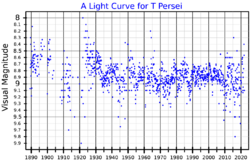Astronomy:T Persei
| Observation data Equinox J2000.0]] (ICRS) | |
|---|---|
| Constellation | Perseus |
| Right ascension | 2h 19m 21.87717s[2] |
| Declination | +58° 57′ 40.3455″[2] |
| Apparent magnitude (V) | 8.34-9.70[3] |
| Characteristics | |
| U−B color index | +2.62[4] |
| B−V color index | +2.33[4] |
| Variable type | SRc[3] |
| Astrometry | |
| Radial velocity (Rv) | −40.85[5] km/s |
| Proper motion (μ) | RA: −1.237[2] mas/yr Dec.: −0.186[2] mas/yr |
| Parallax (π) | 0.4119 ± 0.0237[2] mas |
| Distance | 2345±55[6] pc |
| Absolute magnitude (MV) | −6.90±0.07[6] |
| Details[6] | |
| Mass | 9-12 M☉ |
| Radius | 510±20 R☉ |
| Luminosity | 45,700+4,400 −4,000 L☉ |
| Surface gravity (log g) | 0.06±0.05 cgs |
| Temperature | 3,750±60 K |
| Metallicity [Fe/H] | −0.35 dex |
| Other designations | |
| Database references | |
| SIMBAD | data |
T Persei is a red supergiant located in the constellation Perseus. It varies in brightness between magnitudes 8.3 and 9.7 and is considered to be a member of the Double Cluster.
T Persei is a member of the Perseus OB1 association around the h and χ Persei open clusters, around 2 degrees north of the centre of the clusters. It is generally treated as an outlying member of the clusters.[7] It lies half a degree away from S Persei, another red supergiant Double Cluster member.
T Per is a semiregular variable star, whose brightness varies from magnitude 8.34 to 9.7 over a period of 2,430 days.[3] Unlike many red supergiants, it does not appear to have a long secondary period.[8][9] It is relatively inactive for the red supergiant star, with low mass loss rate 8×10−6 Solar_mass/year and no detectable dust shell.[10]
The Washington Double Star Catalog lists T Persei as having a 9th magnitude companion 0.1 arc-seconds away. This is derived from Hipparcos measurements. However, no other sources report a companion.[11]
References
- ↑ "Download Data". AAVSO. https://www.aavso.org/data-download.
- ↑ 2.0 2.1 2.2 2.3 2.4 Brown, A. G. A. (2021). "Gaia Early Data Release 3: Summary of the contents and survey properties". Astronomy & Astrophysics 649: A1. doi:10.1051/0004-6361/202039657. Bibcode: 2021A&A...649A...1G. Gaia EDR3 record for this source at VizieR.
- ↑ 3.0 3.1 3.2 Samus, N. N. et al. (2009). "VizieR Online Data Catalog: General Catalogue of Variable Stars (Samus+ 2007-2013)". VizieR On-line Data Catalog: B/GCVS. Originally Published in: 2009yCat....102025S 1. Bibcode: 2009yCat....102025S.
- ↑ 4.0 4.1 Ducati, J. R. (2002). "VizieR Online Data Catalog: Catalogue of Stellar Photometry in Johnson's 11-color system". CDS/ADC Collection of Electronic Catalogues 2237. Bibcode: 2002yCat.2237....0D.
- ↑ Famaey, B.; Jorissen, A.; Luri, X.; Mayor, M.; Udry, S.; Dejonghe, H.; Turon, C. (2005). "Local kinematics of K and M giants from CORAVEL/Hipparcos/Tycho-2 data. Revisiting the concept of superclusters". Astronomy and Astrophysics 430: 165. doi:10.1051/0004-6361:20041272. Bibcode: 2005A&A...430..165F.
- ↑ 6.0 6.1 6.2 Baron, F.; Monnier, J. D.; Kiss, L. L.; Neilson, H. R.; Zhao, M.; Anderson, M.; Aarnio, A.; Pedretti, E. et al. (2014). "Chara/mirc Observations of Two M Supergiants in Perseus Ob1: Temperature, Bayesian Modeling, and Compressed Sensing Imaging". The Astrophysical Journal 785 (1): 46. doi:10.1088/0004-637X/785/1/46. Bibcode: 2014ApJ...785...46B.
- ↑ Gonzalez, Guillermo; Wallerstein, George (2000). "Elemental Abundances in Evolved Supergiants. II. The Young Clusters H and χ Persei". The Astronomical Journal 119 (4): 1839. doi:10.1086/301319. Bibcode: 2000AJ....119.1839G.
- ↑ Cite error: Invalid
<ref>tag; no text was provided for refs namedkiss - ↑ Percy, John R.; Sato, Hiromitsu (2009). "Long Secondary Periods in Pulsating Red Supergiant Stars". Journal of the Royal Astronomical Society of Canada 103 (1): 11. Bibcode: 2009JRASC.103...11P.
- ↑ Gordon, Michael S.; Humphreys, Roberta M.; Jones, Terry J.; Shenoy, Dinesh; Gehrz, Robert D.; Helton, L. Andrew; Marengo, Massimo; Hinz, Philip M. et al. (2017). "Searching for Cool Dust. II. Infrared Imaging of the OH/IR Supergiants, NML Cyg, VX SGR, S per, and the Normal Red Supergiants RS per and T per". The Astronomical Journal 155 (5): 212. doi:10.3847/1538-3881/aab961. Bibcode: 2018AJ....155..212G.
- ↑ Mason, Brian D.; Wycoff, Gary L.; Hartkopf, William I.; Douglass, Geoffrey G.; Worley, Charles E. (2001). "The 2001 US Naval Observatory Double Star CD-ROM. I. The Washington Double Star Catalog". The Astronomical Journal 122 (6): 3466. doi:10.1086/323920. Bibcode: 2001AJ....122.3466M.
 |


